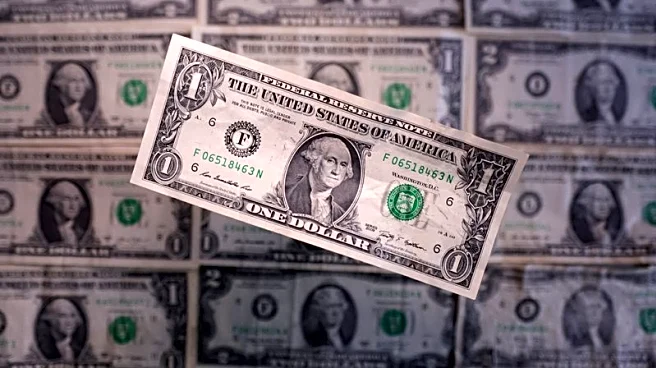What's Happening?
Gold prices have shown significant strength, marking a third consecutive session of gains, with December gold futures closing at $3,477 per troy ounce. This increase is largely attributed to the persistent weakness of the US dollar and evolving expectations regarding Federal Reserve monetary policy. The US dollar has declined by approximately 0.30% against major currencies, creating a favorable environment for dollar-denominated commodities like gold. Additionally, US 10-year Treasury yields have dropped to their lowest levels in two weeks, as market participants anticipate potential Federal Reserve policy easing. Recent comments from Federal Reserve officials, including New York President John Williams, suggest a more balanced approach to future rate decisions, with a significant probability of a rate cut in September.
Why It's Important?
The developments in gold prices and Federal Reserve policy expectations have broader implications for the US economy and financial markets. A potential rate cut by the Federal Reserve could signal a shift towards more accommodative monetary policy, which may support economic growth but also impact inflation and currency values. The weakening dollar benefits exporters and could lead to increased competitiveness of US goods abroad. However, it also raises concerns about inflationary pressures. Investors are closely monitoring economic indicators, such as GDP figures and jobless claims, to gauge the health of the economy and the likelihood of further monetary easing. The outcome of these developments will influence investment strategies and market dynamics, particularly in the precious metals sector.
What's Next?
The trajectory of gold prices and Federal Reserve policy will largely depend on upcoming economic data releases, including the Personal Consumption Expenditures (PCE) inflation report. This report is expected to be a critical determinant of future monetary policy decisions. Should the data support the case for rate cuts, gold may continue to find support, while any deviation could alter market expectations. Additionally, institutional sentiment towards gold, as indicated by exchange-traded fund flows, will play a role in shaping future price movements. Market participants are preparing for potential rate cuts by December, contingent on economic data supporting policy easing.
Beyond the Headlines
The current situation highlights the complex interplay between monetary policy, currency dynamics, and commodity markets. The Federal Reserve's approach to balancing economic growth and inflation will have long-term implications for financial stability and investor confidence. The potential for rate cuts underscores the challenges faced by policymakers in navigating economic uncertainties and maintaining independence. Furthermore, the renewed interest in gold as a safe-haven asset reflects broader concerns about geopolitical tensions and currency debasement, which could influence investment trends and portfolio allocations in the future.












